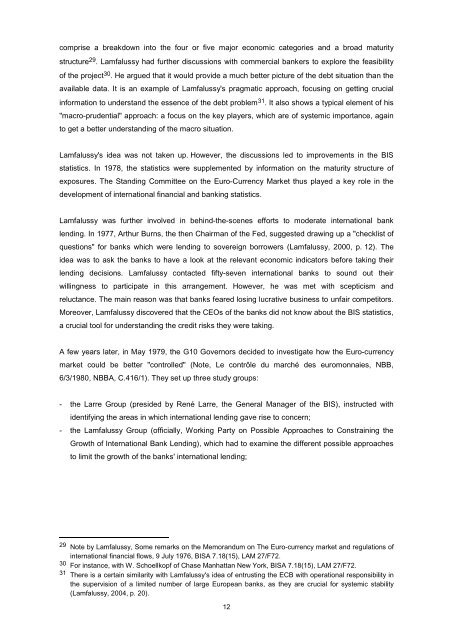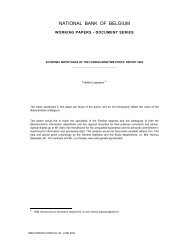Working Paper Research - Nationale Bank van België
Working Paper Research - Nationale Bank van België
Working Paper Research - Nationale Bank van België
You also want an ePaper? Increase the reach of your titles
YUMPU automatically turns print PDFs into web optimized ePapers that Google loves.
comprise a breakdown into the four or five major economic categories and a broad maturitystructure 29 . Lamfalussy had further discussions with commercial bankers to explore the feasibilityof the project 30 . He argued that it would provide a much better picture of the debt situation than theavailable data. It is an example of Lamfalussy's pragmatic approach, focusing on getting crucialinformation to understand the essence of the debt problem 31 . It also shows a typical element of his"macro-prudential" approach: a focus on the key players, which are of systemic importance, againto get a better understanding of the macro situation.Lamfalussy's idea was not taken up. However, the discussions led to improvements in the BISstatistics. In 1978, the statistics were supplemented by information on the maturity structure ofexposures. The Standing Committee on the Euro-Currency Market thus played a key role in thedevelopment of international financial and banking statistics.Lamfalussy was further involved in behind-the-scenes efforts to moderate international banklending. In 1977, Arthur Burns, the then Chairman of the Fed, suggested drawing up a "checklist ofquestions" for banks which were lending to sovereign borrowers (Lamfalussy, 2000, p. 12). Theidea was to ask the banks to have a look at the rele<strong>van</strong>t economic indicators before taking theirlending decisions. Lamfalussy contacted fifty-seven international banks to sound out theirwillingness to participate in this arrangement. However, he was met with scepticism andreluctance. The main reason was that banks feared losing lucrative business to unfair competitors.Moreover, Lamfalussy discovered that the CEOs of the banks did not know about the BIS statistics,a crucial tool for understanding the credit risks they were taking.A few years later, in May 1979, the G10 Governors decided to investigate how the Euro-currencymarket could be better "controlled" (Note, Le contrôle du marché des euromonnaies, NBB,6/3/1980, NBBA, C.416/1). They set up three study groups:- the Larre Group (presided by René Larre, the General Manager of the BIS), instructed withidentifying the areas in which international lending gave rise to concern;- the Lamfalussy Group (officially, <strong>Working</strong> Party on Possible Approaches to Constraining theGrowth of International <strong>Bank</strong> Lending), which had to examine the different possible approachesto limit the growth of the banks' international lending;29 Note by Lamfalussy, Some remarks on the Memorandum on The Euro-currency market and regulations ofinternational financial flows, 9 July 1976, BISA 7.18(15), LAM 27/F72.30 For instance, with W. Schoellkopf of Chase Manhattan New York, BISA 7.18(15), LAM 27/F72.31 There is a certain similarity with Lamfalussy's idea of entrusting the ECB with operational responsibility inthe supervision of a limited number of large European banks, as they are crucial for systemic stability(Lamfalussy, 2004, p. 20).12
















